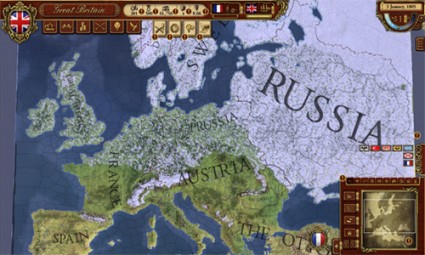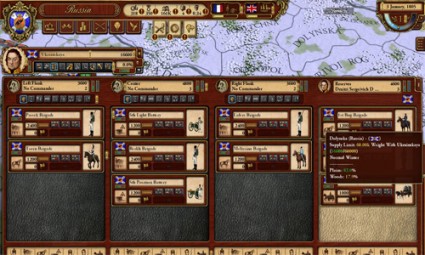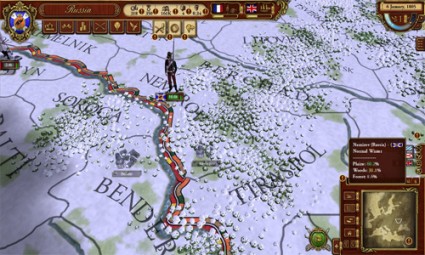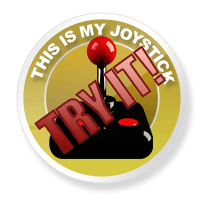Reviews
March of the Eagles
March 22, 2013, Author: Trent Pyro
As a child, the endlessly popular strategy game RISK baffled me. Now 24 years old, it still baffles me. With its myriad of rules, conditions and situations it manages to make something as simple as conquering the known world surprisingly complex.
Okay, so maybe it’s not that surprising, but what’s interesting is that over the years little attempt has been made to simplify the game for any new generations. RISK has remained the hardcore choice for dedicated strategists, and Paradox Interactive’s March of the Eagles looks to recreate that difficult-to-learn, even-more-difficult-to-master formula on your PC. Does the presence of a clever AI and an intuitive interface curb the initial feelings of bewilderment and the coming complications of world domination? Hell, no…
It’s all about dominance…
March of the Eagles (MOTE) doesn’t really have much of a story, although it seems to roughly follow historical situations. These situations are only really ever used as jumping-off points for the game’s various missions though, each one taking you a step closer to your goal.
The idea is that you can reshape history as you see fit, leading the tiny Persia to European dominance or starting an unprecedented allegiance between France and Britain to take over Russia. While the game allows you to play fast and loose with actual history, in essence it’s extremely accurate. Down to the way troops are recruited and commanded, each battalion, fleet and division is typical of the type found in that country in that time period. It seems much effort has gone into impressing history buffs and the air of authenticity present is palpable.
This does, however, lead to the distinct feeling of a twelve-part History Channel series, along with all the excitement and bombast that usually comes along with it. I jest of course; MOTE is as humourless as a funeral and that can make it an incredibly draining grind at times. Thankfully the gameplay is deep and complex enough to take your mind off the dull setting… if you can get your head around it.
The menus, oh God, the menus!
To say MOTE is complicated is like saying rocket science is a bit hard. It is by far the most baffling, complex and overwhelming RTS I’ve ever laid eyes on. It’s also the most deep by far, allowing an insane amount of control over the tiniest details of your army, navy and country. To explain every mechanic and control system would take thousands of words, so I’ll just give you guys the overview.
The goal of each campaign is to conquer all the other countries through land or naval dominance or various treaties and agreements. You begin with a number of troops and ships, organised into divisions and fleets respectively. Each division is named after the area the men are from and each fleet has a purpose. The number of troop and ship types is staggering and understanding how to use each type effectively is one of the key aspects of the game.
New troops can be recruited and new ships can be built, but this takes time and money, two resources you have a limited amount of. Money is generated by complex web of taxes, reparations, deals and agreements that basically boils down to ‘You get X amount of money Y times a year’.

There’s Europe. Conquer it. Simple as that.
Time passes as quickly or as slowly as you want to, with full control given to you over how fast things move. It may be tempting to rocket the speed at first, as at the default speed it can take whole minutes for troops to make their way across small distances. Be warned though; this game can get away from you faster than The Flash in a hurry. Regardless of whether you’re making any moves the rest of the map goes on and if you lose focus for a short time you can quickly become overwhelmed.
The game takes almost no account of your experience level, expecting you to come in as a solid tactician and only get better. Thankfully there’s a handy pause option on the space bar, allowing you to quickly stop time and have a think. Any commands or movements you set when in pause mode activate as soon as you exit it, and using it liberally is not only advised but essential.
Combat is, again, initially baffling and even once you get the hang of it, it remains a confusing affair. Partly down to the rudimentary representation of your troops, you’re never quite sure if you’ll win a fight or not. Superior numbers usually help, but a smaller force that’s better led or better organised can trounce you. The ability to organise your divisions into flanks and assign commanders with different skills is great, but unless you understand the benefits of each formation it’s entirely useless.
Commanding ships is even more confusing and not once in my time with the game did I manage to use any of the combat ships effectively, if at all. It’s somehow not as simple as selecting a fleet and right-clicking an enemy fleet, and even when my ships are in the vicinity of enemies they seem to be reluctant to attack. I mainly used them for transporting troops across the Channel and blockading ports to aid sieges, both of which are simple and effective.
Diplomacy is, as always, a minefield, but it can be a very effective way of making things easier. An early agreement of Military Passage with The Ottomans (allowing my troops to pass through their lands without causing a war) made conquering Persia and most of Eastern Europe much easier. Although once they decided to nix the agreement and declare war on me because my troops couldn’t get off their turf in time, things got a little tricky.
The biggest issue I have with MOTE is the interface. As intuitive as it is, it requires a huge amount of practice and a talent for remembering processes to use effectively, and using it as such is paramount. Unlike most games (even most RTSs), where you start with the basics and are slowly introduced to the more complex actions, MOTE simply gives you a barely effective tutorial and assumes you know how to use everything. Either due to bad translation or simply a lack of information, the myriad tooltips and hints that litter the interface often raise more questions than they answer. You get no consideration for your inexperience; it’s as if the game expects you to be awesome the moment you turn it on.

Seriously, what the hell does all of this mean?!
Now this could be misconstrued as the whining of a guy who just sucks at RTS games, but generally I don’t. I’m quite good with tactics, planning and wargames; just not on this scale. It’s one thing being good at commanding a small force, tracking enemy movements and setting up ambushes and reserves; it’s another thing entirely overseeing a European campaign encompassing hundreds of thousands of troops and numerous supply lines, battlefronts and enemies.
It’s like being told the basic rules of Texas Hold ‘Em and then being thrown into the PKR World Championships without so much as a practice game. You expect to fail and when you do, instead of feeling beaten but determined to learn from your mistakes, you simply feel cheated and are told to try again but given no advice on how to do better.
RISK 3D!
Graphically MOTE is functional and resembles an animated game of, you guessed it, RISK. That’s the best term to use and never has it been so appropriate. The main screen is essentially a bare-bones map of Europe circa early-19th century, and everything is represented by a basic avatar. Troop formations are shown as a solitary soldier, while entire fleets are shown as single ships. Towns are clutches of a few buildings, all the same no matter what country they’re in.
While the landscape is geographically correct, it’s immensely boring to look at and the severe lack of visual feedback from anything makes the game a case of clicking things and waiting for the numbers to change. A siege, for instance, is represented by a small box in the bottom-left of the screen that occasionally changes when the situation does.
Fidelity and detail obviously weren’t a concern for Paradox, although that does mean MOTE will likely run on most machines. My mid-range rig barely has to work at all to display the basic textures at full-spec, and the entire thing looks much older than it actually is. While this won’t be a concern for seasoned grand strategy gamers for whom the minutiae are more important than the visuals, for those hoping to segue in from more small-scale affairs it’s disappointingly basic.

Russia looks like a pretty empty place back then.
Worthy of note is the use of colour, or lack thereof. Everything in the interface is red or reddy-brown, and it can be hard to figure out which window you’re looking at without constantly checking the tiny title text. Colour-coding the tabs would’ve helped organisation loads, and the fact that most troops look the same colour irrespective of origin makes figuring out a crowded theatre of war a tedious chore of clicking soldiers and waiting for tooltips.
A-ten-hut!
MOTE is devoid of sound aside from the constantly looping soundtrack and the occasional sound effect to indicate some kind of change in the game. A paradiddle when you move troops, a battlecry when the engage in combat; as basic as the graphics, the sound production here is so minimal you’d think a modeller did it in their spare time.
Said soundtrack is fine, with the usual epic orchestral tracks that make you think of endless historical soldiers cutting each other down on the plains of Europe.
Supply lines cut
While there is a multiplayer component to MOTE it’s so old-fashioned that anything resembling a lobby is absent. Unless you know the IP address of the person you want to battle it’s impossible to find a game, and not knowing anyone else with the game I couldn’t test it. It’s baffling that this game has been released on Steam, yet the devs neglected to implement support for the system’s effective game invite method.
A matter of perspective
March of the Eagles is either the most detailed grand strategy game to come out in recent years, or an impossible-to-play tangled web of over-complex mechanics drowning in its own ambition. It’s all entirely dependent on your background. If you’ve mastered Age of Empires and can conquer Rome in your sleep then maybe MOTE is the next step for you. RISK veterans will likely already understand the subtle skills needed to manage a military campaign on this scale and may relish in the sheer amount of options available.
Newcomers to the strategy genre, however, face an incredibly steep learning curve and one that rewards success with very little fanfare. The lack of visual feedback and anything that could be described as ‘flashy’ makes MOTE a very difficult game to enjoy if you’re not into epic levels of micromanagement.
It’s like swimming. Throw a beginner in the sea and they will drown in the waves; toss an experienced swimmer in and they’ll relish the space and freedom the water gives them. So before you decide whether to sink your teeth into MOTE, ask yourself: if you’re pushed head-first into this crashing tempest of a game, will you be able to stay afloat? I know I certainly could not.
Platforms: PC | Tagged complex, deep, Europe, grand, March of the Eagles, military, Napoleonic, old multiplayer, Paradox Interacitve, PC, RISK, RTS, ships, Steam, steep learning curve, Strategy, troops, Warfare



